An Altered state of consciousness is any state that differs
significantly from baseline or normal waking consciousness. This
waking consciousness is a fragmented stream while deep altered
consciousness is characterized by wholeness and unity.
An intense Altered State can be induced through years of meditative
practice
or, sometimes, by ingesting chemical substances.
All of us have experienced altered consciousness at some time
in our lives. In normal life, one may slide into mild altered
states while daydreaming, being absorbed in a television programmed,
listening to music or, sometimes, through euphoric lovemaking.
A growing number of people are now experiencing a variety of
non-ordinary states of consciousness. These include near-death
experiences, past-life memories, out-of-body travel, intuitive
knowledge, telepathy and clairvoyance..
Extrasensory phenomena such as telepathy, clairvoyance, intuition
and channeling are also supposed to be honed in Altered
States of awareness. Today, a host of traditional and new techniques
are available to induce altered states. Meditation, yoga, tantra,
drumming, chanting, ecstatic dance, hypnosis, sensory deprivation,
sensory overload, biofeedback, mind-music, electronic brain machines
and chemicals among others are in use.

ECG studies show the existence of four brain wave patterns:
beta, alpha, theta and delta. Beta waves appear in waking awareness,
theta in dreaming and delta in deep sleep. Alpha rhythms, which
register at 8-13 Hz, manifest in almost every study of altered
states. Alpha’s main feature is a calm, alert and relaxed
awareness. Different types of meditation produce different electrical
patterns. But advanced meditation has been found to produce all
the four waves and an unnamed range around 30-50 Hz. Neurologists
attribute the ecstatic states and physical well-being found in
mediators to the rush of neurochemicals including the body’s
opiates, the endorphins and the ‘joy juices’ such
as norepinephrine and dopamine. Meditation also synchronizes
the logical left and the creative right hemispheres of the brain,
producing experiences of timelessness, interconnectedness and
bliss. Whole brain functioning facilitates access to altered
states that activate the unused potential of the brain.
Now you can measure
your progress ,,,,No more Guesswork
What is Biofeedback?
Chances are you have used biofeedback yourself. You've used
it if you have ever taken
your temperature or stepped on a scale. The thermometer tells you whether you're
running a fever, the scale whether you've gained weight. Both devices "feed
back"
information about your body's condition. Armed with this information, you can
take steps you've
learned to improve the condition. When you're running a fever, you go to bed
and drink
plenty of fluids. When you've gained weight, you resolve to eat less and sometimes
we
do :)
Your biofeedback device acts as a kind of sixth sense which
allows you to" see" or "hear" activity inside
our bodies. One commonly used type of machine, for
example, picks up electrical signals in the skin. It translates these signals
into a form
that we can detect: It triggers a flashing light bulb, perhaps, or activates
a beeper every
time we grow more tense. If we want to relax tense muscles, they try to slow
down the flashing
or beeping.
Like a pitcher learning to throw a ball across a home plate,
the biofeedback user, in an
attempt to improve a skill, monitors the performance. When a pitch is off the
mark, the
ballplayer adjusts the delivery so that he performs better the next time he
tries. When the
light flashes or the beeper beeps too often, the biofeedback user makes
internal
adjustments which alter the signals.
Brainwaves and Brain Mapping
The Ultimate
Biofeedback Tool
The brain consists of about 20 billion neurons which all generate
electrical impulses. When these neurons work together in synchrony,
tiny rhythmic, electrical potentials occur in the synapses which
are specialised junctions between the neurons. The more neurons
that work in synchrony, the larger the potential (amplitude)
of the electrical oscillations measured in microvolts. The faster
the neurons work together, the higher the frequency of the oscillations
measured in Hertz. These two parameters: amplitude and frequency
are the primary characteristics of brain waves.
These weak electrical signals can be measured by electrodes
placed on the scalp. After amplification
by an EEG-amplifier, the signals are fed to a computer and analysed
for amplitude and frequency. This is called Electroencephalography
(EEG).
BRAINMAPPING
ALTERED STATES
OF CONSCIOUSNESS

Brainmaps give a quick overview of the functional
state of the brain. The brainmap above shows five coloured ovals
displaying the distribution in the brain of five types of brain
waves. The oval in the upper left corner actually shows a combination
of Beta2 and Gamma frequencies. Each oval shows the brain seen
from above, and the little tip at the top indicates the location
of the nose. Each of the five ovals only displays one type of
brain wave, however, all five types of waves are measured at
the same time and at the same locations on the brain. Thus, the
brainmap splits up the complex brain wave activity on five different
displays in order to give a better overview.
Usually activation of the brain will show up in
the brainmap as decreased Theta and Alpha and increased Beta1
and Beta2 activity. On the other hand, if the subject relaxes
and connects to his/her unconscious, we would tend to see an
increase of Alpha and Theta activity.
Through quantitative EEG
brainmapping techniques it is possible
to map and compare different states of consciousness. The below
brainmaps displays one normal and five altered states of consciousness
QEEG data and brainmaps from four different studies of altered
states of consciousness will be presented. A comparison will
be made of QEEG changes during Feeling Release, Kriya Yoga Meditation,
Ayahuasca-induced Trance States and Sexual Orgasm. In all four
studies eight channels of EEG were recorded (Fp1, Fp2, T3, T4,
T5, T6, O1, O2) and analysed for theta (4-8Hz), alpha (8-13Hz)
and beta (13-20Hz) frequencies using portable, computerized
equipment. Graphs and coloured brainmaps will be presented
demonstrating similarities and differences between these four
states.
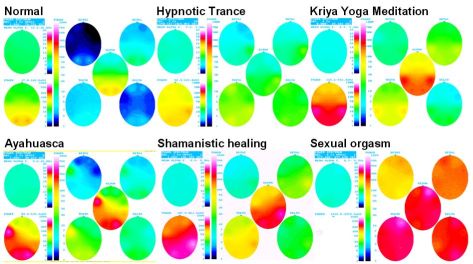
Paper presented by Erik Hoffmann at the Winter
Brain Conference on Neurofeedback, Miami Beach, February 7-11,
2001
In a study of intense Feeling Release in 20 patients
at the Primal Center in Los Angeles large and statistically significant
increases of both alpha and theta activity were found following
release therapy. The increase of alpha following therapy
was usually higher in the right than in the left hemisphere and
higher in the back than in the front part of the brain.
Real-time brainmaps showed high alpha/theta/delta amplitudes
shooting up in various parts of the brain at the exact moment
the patient regressed in therapy and dropped into an old feeling.
This pattern was usually repeated many times during a session
and the correlation between EEG changes and behaviour was consistently
high.
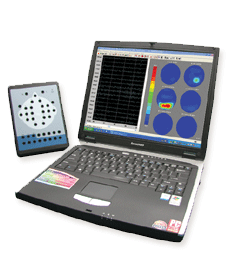
When you go into deep
meditation you get better access to your unconscious.
Sometimes you may even re-experience old painful traumas.
We have the opportunity to measure this process of confronting
old painful memories using EEG brainmapping methods
 . .
Your sessions can now be recorderd on
your hardrive and played back after you or your clients meditation
session or
therapy session
The brainmap to the
far left in the above picture shows the subject's baseline
activity with closed eyes just before she
confronted the deep pain. At this point she told us that she
was holding back the pain and we see how large amounts of Beta1
and Beta2 activity is shooting up in her left frontal and temporal
areas. Apparently high Beta activity in these areas can block
access to the unconscious pain. One minute later she descends
down into the pain voluntarily, the Beta activity disappears
and is substituted by widespread Alpha and Theta activity.
Four minutes later, when the pain is at maximum, there is an
expansion
of consciousness and Alpha and Theta waves reach very high
amplitudes. We suggest that our subject now has full access to
her unconscious.
In that state of high Alpha and Theta waves she is apparently
holding the painful experience in a conscious space observing
it passively.

Mapping the brains activity after Kriya Yoga
The wanted to study the effects of Kriya Meditation on the brain’s
activity (EEG). In the scientific litterature there are often
reports of an increase in alpha and theta waves during and after
various forms of meditation. The ancient Tantric Kriya Yoga is
a powerful method for awakening and expanding consciousness,
as well as for strengthening the vital and psychic energy. We
therefore anticipated that the EEG measurements before and after
a single Kriya Yoga session would show significant changes. Furthermore,
we wanted to map the brain’s activity on coloured brainmaps
before and after one session of Kriya Yoga Meditation. Source
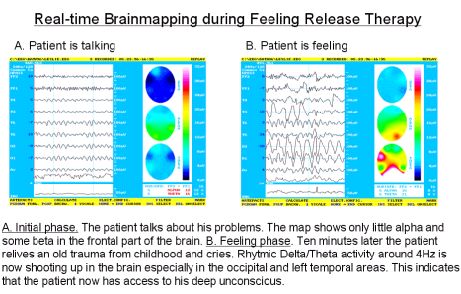
Real-time brainmaps showed high alpha/theta/delta
amplitudes shooting up in various parts of the brain at the exact
moment the patient regressed in therapy and dropped into an old
feeling. This pattern was usually repeated many times during
a session and the correlation between EEG changes and behaviour
was consistently high.

The Complete Monroe Catalog

In
another study* this author found that patients in release therapy
also showed large increases of Alpha
and Theta activity when they were reliving personal, painful
traumas from their childhood. Thus, both brain mapping studies
point to the fact that when you access the unconscious in order
to relive and heal old traumas, consciousness will expand with
increasing Alpha and Theta levels thus confronting, containing
and eventually integrating the pain. If the above assumptions
are correct, we may have begun to disclose the mechanism of repression.
See Primal Therapy.
*Unpublished data, The Primal Center, Los Angeles 1995
EEG asymmetry and heart rate
during experience of hypnotic analgesia in high and low hypnotizables.
EEG spectral analysis during hypnotic induction,
hypnotic dream and age regression.


How is Biofeedback Used Clinicaly Today?
Clinical biofeedback techniques that grew out of the early laboratory
procedures are now
widely used to treat an ever-lengthening list of conditions.
These include:
·
Migraine headaches, tension headaches, and many other types of
pain
·
Disorders of the digestive system
·
High blood pressure and its opposite, low blood pressure
·
Cardiac arrhythmias (abnormalities, sometimes dangerous, in the
rhythm of the heartbeat)
·
Raynaud's disease (a circulatory disorder that causes uncomfortably
cold hands)
·
Epilepsy
·
Paralysis and other movement disorders
| From quantum physics to telepathy, psycho kinesis and
dream states, Mind Tools are finally expanding its horizons
to match the evolving consciousness. The question is, will
the seeds
of this integration fructify into awareness? |
How Does Biofeedback Work?
Scientists cannot yet explain how biofeedback works. Most Users
who benefit from
biofeedback are trained to relax and modify their behavior. Most
scientists believe that
relaxation is a key component in biofeedback treatment of many
disorders, particularly
those brought on or made worse by stress.
Their reasoning is based on what is known about the effects of
stress on the body. In brief,
the argument goes like this: Stressful events produce strong
emotions, which arouse
certain physical responses. Many of these responses are controlled
by the sympathetic
nervous system, the network of nerve tissues that helps prepare
the body to meet
emergencies by "flight or fight."
The typical pattern of response to emergencies probably emerged
during the time when all
humans faced mostly physical threats. Although the "threats" we
now live with are
seldom physical, the body reacts as if they were: The pupils
dilate to let in more light. Sweat
pours out, reducing the chance of skin cuts. Blood vessels near
the skin contract to reduce
bleeding, while those in the brain and muscles dilate to increase
the oxygen supply. The
gastrointestinal tract, including the stomach and intestines,
slows down to reduce the
energy expensed in digestion. The heart beats faster, and blood
pressure rises.
Normally, people calm down when a stressful event is over especially
if they have done
something to cope with it. For instance, imagine your own reactions
if you're walking
down a dark street and hear someone running toward you. You get
scared. Your body
prepared you to ward off an attacker or run fast enough to get
away. When you do escape,
you gradually relax.
| We exist in a predominantly "fear
based" world and are surrounded by those that "perceive" the
physical events, conditions and circumstances that unfold
in our immediate physical environment to be "real."
Seriously...think about it. The predominant mainstream
media is consistently inundating us with what's "wrong" in
the world, growing up we're conditioned and programmed
with information that's intended to keep us "free
from harm" rather than teaching us how to live and
thrive. Our school systems are created to check off and
tell us what we did "wrong" on our tests and
papers and even our religions tell us how unworthy we are.
Combine all these factors with the fact that everybody
and his brother in our individual circles of influence
are consistently talking about "how bad" the
current conditions in the world are, completely oblivious
and unaware that they have the ability to do anything about
it.
Sure we could run away and go hide in a cave somewhere,
separate ourselves from all the "junk" information
that surrounds us and become a monk or a hermit or we could
choose another alternative that effectively deals with these
issues at a neurological level regardless of what we're consistently
exposed to.
This alternative is called neurological reconditioning.
And these
are the Major Tools |
If you get angry at your boss, it's a different matter. Your
body may prepare to fight. But
since you want to keep your job, you try to ignore the angry
feelings. Similarly, if on the
way home you get stalled in traffic, there's nothing you can
do to get away. These situations
can literally may you sick. Your body has prepared for action,
but you cannot act.
Individuals differ in the way they respond to stress. In some,
one function, such as blood
pressure, becomes more active while others remain normal. Many
experts believe that
these individual physical responses to stress can become habitual.
When the body is
repeatedly aroused, one or more functions may become permanently
overactive. Actual
damage to bodily tissues may eventually result.
Biofeedback is often aimed at changing
habitual reactions that
can cause pain or
disease.
Hemispheric synchronization
Hemispheric synchronization is a technical term that
has a simple meaning.
Hemisphere means half of a sphere. In this case
it is referring to half of your brain. Synchronization means
that two systems are working in unison.

The Complete Monroe Catalog

The two halves of your brain - left and right -
are connected by the corpus callosum. The right side of your
brain is responsible for emotions and creative work.
The left side of your brain deals with logic, reason, and language.
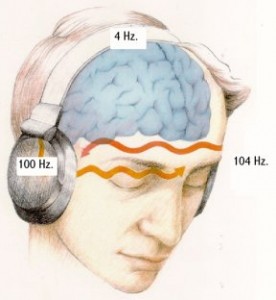
Both sides of the brain are equally active but
one side may do more than the other at certain
times or perhaps predominantly more as in the case of depression
where the right side is busier than the left.
Two Halves
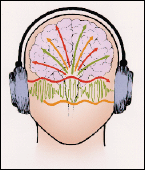
When both sides of the brain are working at similar
levels the person is generally successful, happy,
healthy, and optimistic. People who pray, meditate, or
who are very content with their lives have both halves
of their brains working in harmony. They have brain synchronization.
Through the use of EEG's scientists
have discovered that emotionally unstable people
and those with Different health issues usually have un-synchronized
brains. That is one half of the brain is working more than
the other.

When both sides of the brain are working at similar
levels the person is generally successful, happy,
healthy, and optimistic. People who pray, meditate, or
who are very content with their lives have both halves
of their brains working in harmony. They have brain synchronization.
Since the discovery of hemispheric synchronization
and what it means to health, it has become something highly
valued and looked for.
The left or analytical hemisphere of the mind
rejects supernatural sources of information. The intuitive
right hemisphere senses a higher power behind creation. Hemispheric
balancing precipitates a "breaking free" if
you will of the physical neurological beliefs created within
the neuro pathways of the brain, initiating and creating
a balance in the right and left brain creating
what is often referred to as a whole brain existence.
In essence it assists those who are predominantly left brain
in nature (logical and analytical) in developing a harmony
and balance balance with the right hemisphere (spiritual)
resulting in achieving more of the desired tangible results
in the various aspects of life.
|